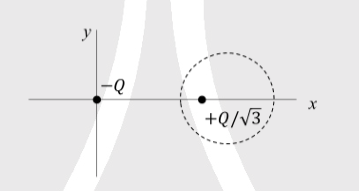A charge of magnitude 10−6 C is placed at the origin. There are two points P(√3,√3) and Q(√6,0). Find potential difference between point P & Q.
To find the potential difference between points P and Q due to a point charge of magnitude q=10−6C placed at the origin, we can follow these steps:
Step 1: Identify the coordinates of points P and Q
- Point P has coordinates P(√3,√3).
- Point Q has coordinates Q(√6,0).
Step 2: Calculate the distances from the origin to points P and Q
- The distance rP from the origin to point P can be calculated using the distance formula:
rP=√(√3)2+(√3)2=√3+3=√6
- The distance rQ from the origin to point Q is:
rQ=√(√6)2+02=√6
Step 3: Calculate the electric potential at points P and Q
The electric potential V due to a point charge is given by the formula:
V=kqr
where k=14πϵ0 is Coulomb's constant, q is the charge, and r is the distance from the charge.
- For point P:
VP=kqrP=k10−6√6
- For point Q:
VQ=kqrQ=k10−6√6
Step 4: Calculate the potential difference VP−VQ
Now, we can find the potential difference between points P and Q:
VP−VQ=(k10−6√6)−(k10−6√6)=0
Conclusion
The potential difference between points P and Q is:
0
- Point P has coordinates P(√3,√3).
- Point Q has coordinates Q(√6,0).
- The distance rP from the origin to point P can be calculated using the distance formula:
rP=√(√3)2+(√3)2=√3+3=√6
rQ=√(√6)2+02=√6
The electric potential V due to a point charge is given by the formula:
V=kqr
where k=14πϵ0 is Coulomb's constant, q is the charge, and r is the distance from the charge.
VP=kqrP=k10−6√6
VQ=kqrQ=k10−6√6
Now, we can find the potential difference between points P and Q:
VP−VQ=(k10−6√6)−(k10−6√6)=0
The potential difference between points P and Q is:
0
Topper's Solved these Questions
Similar Questions
Knowledge Check
An electric charge 10−3μC is placed at the origin (0,0) of x-y coordinate system. Two points A and B are situated at (√2,√2) and (2,0) respectively. The potential difference between the points A and B will be
AzeroB9VC4.5 VD2VAn electric charge 10−3μC is placed at the origin (0,0) of X-Y coordinate system. Two points A and B are situated at (√2,√2) and (2,0) respectively. The potential difference between the points A and B will be
A9 VBzeroC2 VD4.5 VAn electric charge 10−3μC is placed at the origin (0,0) of X-Y coordinate system. Two points A and B are situated at (√2,√2) and (2,0) respectively. The potential difference between the points A and B will be
A9 VBzeroC2 VD4.5 V
2μC charge is shifted from "P" to "Q" .If workdone by external force in this process is 160×10−6 joule,then potential difference between points "P" and "Q" i.e.VP−VQ is
View SolutionA charge q1=2.00μC is located at the origin , and a charge q2=−6.00μC is located at (0,3.00)m.
(a) Find the total electric potential due to these charges at the point P hose coordinates are ( 4.00,0) m .
( b) Find the change in potential energy of the system of two charges plus a charge q3=3.00μC as the latter charge moves from infinity to point P .
View SolutionTwo point charges −Q and +Q√3 are placed in the xy plane at the origin (0,0) and a point (2,0) resp as shown in figure. This results in an equipotential circle of radius R and potential V=0 in the xy plane with its center at (b,0). All lengths are measured in meters.
 The value of b is ....m
The value of b is ....m
View SolutionAn electric charge 10−3μC is placed at the origin (0, 0) of X-Y co-ordinate system. Two points A and B are situated at (√2,√2) and (2, 0) respectively. The potential difference between the points A and B will be
View SolutionIf the distance between the points (3,6) and (p,10) is 2√5, then the value of p is :
View Solution

